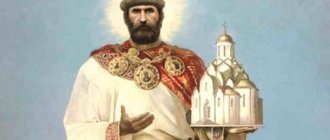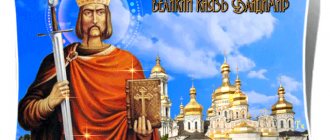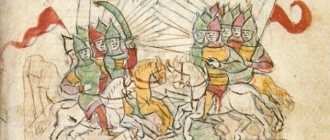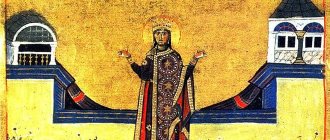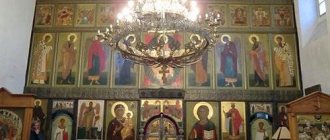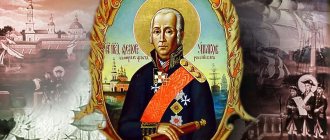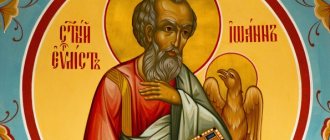Every king, emperor or king during his reign tries to do something for his people that his descendants will talk about, which will leave a mark on history . Prince Vladimir is no exception. The historical significance of this personality in the development of Russia, its formation and reformation is great. Moreover, it is decisive .
During the reign of Vladimir, the baptism of Rus' took place, a charter appeared, coins began to be minted, and the Slavic lands were united under one flag. In addition, Kievan Rus expanded its borders with numerous raids and wars, which earned the recognition of other states. All these events determined the fate of Russia for many centuries to come.
Parents and origin
Mother of Vladimir Malush, monument
Information about the birth of Vladimir and the first years of his life is contained in the Tale of Bygone Years and the later Nikon and Ustyug Chronicles. It is known that he was the third, youngest son of Prince Svyatoslav and a certain Malusha, housekeeper (or almswoman) of Princess Olga.
The word “alms” itself is interpreted by historians in different ways. Perhaps Malusha was distributing alms on behalf of Princess Olga, and perhaps the term “almswoman” indicates her special position as the favorite and favorite of the princess, living “out of mercy.”
Almost nothing is known about the origins of Vladimir’s mother. Historians A. A. Shakhmatov, B. A. Rybakov, D. I. Prozorovsky, N. I. Novikov put forward the following versions:
- she was the daughter of the Novgorod citizen Kalufch and, together with her sister and brother, was sent to Kyiv in the service of Princess Olga (her status is not defined as slave);
- Malusha's father was a certain Malk Lubchanin, who accompanied the envoy of the German Emperor Otto I, Bishop Adalberg, to Kyiv (after the failure of the bishop's mission, Malk's children remained with Princess Olga in Kyiv as pupils);
- she was born in the Baltic city of Lyubich, and her father was the Drevlyan prince Mal, killed by Olga (according to this version, she is a princess and was legally married to Svyatoslav; the possible reliability of this version is indicated by the high position of her brother Dobrynya in Kyiv).
Interesting. Only Nestor speaks about Malushi’s slave status in the story about Vladimir’s matchmaking with the Polotsk princess Rogneda. The princess refused the prince, citing the fact that he was a “rabichich,” that is, the son of a slave.
Presumably, somewhere between 942-960, Malusha becomes pregnant and is sent to the village of Budyatin to give birth. Nestor, describing these events, says that Olga was very angry and sent Malusha into exile, believing that she had committed the sin of adultery.
There are also several versions about Vladimir’s birthplace, the village of Budyatin:
- Budyatin, or Budnik, is a village near Pskov, which belonged either to Princess Olga herself, or was donated to Malusha;
- Budyatichi is a village near Vladimir-Volynsky (the territory of modern Ukraine).
Soon after Vladimir's birth, he is taken from his mother and sent to Kyiv. In the first few years, Princess Olga herself was involved in his upbringing. This fact also indicates that the boy’s mother could not have been a slave, otherwise the Christian Olga would not have recognized the bastard and would not have raised him along with his legal heirs.
After the death of his grandmother, Vladimir was raised by his maternal uncle Dobrynya (according to the Scandinavian tradition, also accepted among the Varangians, the boy’s closest relative is considered not his father, but his maternal uncle, in whose family he is raised until adulthood). Later, on the orders of Svyatoslav’s father, Vladimir and his uncle go to reign in Novgorod. There he learns the basics of governing the country, learns the art of war, strengthens ties with his Norman relatives and fights the separatism of the local Finno-Ugric population.
Interesting. Almost nothing is known about the further fate of Vladimir’s mother. In the Scandinavian “Saga of the Jomsvikings” there is a mention of the mother of Prince Gardariki Vladimir, a perspicacious old woman who predicted the reign of Olaf I the Saint in Norway (Olaf was saved from Estonian captivity by his uncle, who was in the service of Vladimir; the boy grew up in Novgorod and was brought up with Vladimir ). There are also references to a certain Malfred (possibly a Scandinavian version of the name Malusha) in the lists of members of the princely family who died between 990-1000. Her name comes after Rogneda’s name, although the family relationship of these two women is not indicated.
The struggle for power between the brothers Yaropolk, Oleg and Vladimir
In 972, Svyatoslav died at the hands of the Pechenegs on the Danube. His eldest son and Olga’s favorite Yaropolk becomes the Prince of Kyiv (according to some sources, he was a Christian just like his grandmother). The next oldest brother, Oleg, remains to rule in Iskorosten, and Vladimir - in Novgorod.
In 975, Oleg kills the son of the Kyiv governor Sveneld (comrade-in-arms of Svyatoslav) Lyut, who organized an illegal hunt in the Drevlyan lands. Sveneld asks Yaropolk to punish his brother. As a result of a military clash near the walls of Iskorosten, Oleg dies. Having received the news of his brother’s death, Vladimir, fearing for his life, decides to flee “overseas” to the Varangians. After his escape, Yaropolk appointed a mayor to Novgorod.
Having secured the support of the Varangians and Normans, Vladimir returns to Rus' three years later, captures Novgorod and decides to go on a campaign against Kyiv in order to avenge the death of his brother Oleg by taking a just victory. In 977, the first princely civil strife began in Rus'.
Matchmaking to Rogneda and the siege of Polotsk
The path to Kyiv was blocked by Polotsk and the lands of the Principality of Polotsk, independent of the power of the Rurikovichs. Prince Rogvold ruled in Polotsk, about whom all that is known is that he “came from overseas.” Perhaps he was a Varangian, or a Norwegian, or a Swede; the exact details of the chronicle were not preserved.
Vladimir tried to come to an agreement with the Prince of Polotsk and even wooed his daughter Rogneda, who refused him, citing his alleged slave origin (“I don’t want to marry Robichich”). But she accepted the offer from Yaropolk, which greatly offended and angered Dobrynya, who demanded that Vladimir seize Polotsk.
V.N. Tatishchev directly writes that Rogvold was an ally of Yaropolk in the internecine war of 977-978, led active military operations against Vladimir and even captured the Novgorod volosts. Thus, Rogneda’s refusal became only a pretext for Vladimir’s invasion of the Polotsk lands.
In the PVL, Ipatiev and Laurentian arches it is mentioned that Vladimir gathered a large army of Varangians, Slovenes, Chuds, Krivichi and captured Polotsk. Prince Rogvold and his sons were killed, and Rogneda (after public violence) became Vladimir’s wife.
Interesting. Vladimir's children from Rogneda, in particular Izyaslav, ruled in Polotsk, considering it their family fiefdom, and not granted by the Kyiv prince. They did not recognize the Rurikovichs and did not consider themselves one of them, calling themselves “Rogvold’s grandchildren.” The Yaroslavichs and Rogvoldichis will often fight among themselves in the future, and Polotsk will pursue a policy independent of Kyiv.
March on Kyiv and the betrayal of Blud
After the capture of Polotsk, Vladimir with the Varangians and the Novgorod squad went to Kyiv. Here a coup was already being prepared in his favor. The governor Blud, bribed by him, convinced Yaropolk to flee from Kyiv to the city of Roven, citing the boyar conspiracy being prepared against him. Yaropolk left the capital and Vladimir freely occupied it.
Already in Rowena, Blud persuaded Yaropolk to negotiate with his brother, promising that they would be alone and without weapons. Yaropolk’s close friend Varyazhko dissuaded the prince, inviting him to flee to the Pechenegs and, together with them, wage war against Vladimir.
Murder of Yaropolk by order of Vladimir
Yaropolk decided to go to negotiations. He freely entered the room where Vladimir was supposedly waiting for him. Blud locked the doors behind him. In the prince’s room they were “taken to the sword” by Varangian mercenaries. Yaropolk died in front of Varyazhko, who miraculously managed to escape.
Chroniclers describe this event differently, but almost none of them condemn Vladimir, citing the fact that the murder of Yaropolk was an initiative of the Varangians and Normans, who benefited from Vladimir’s reign. It is only known that after the murder of his brother, Vladimir “forgot” to pay off the mercenaries, sending them to Byzantium, having previously written to the emperor in Constantinople to send them to serve in different places.
Interesting. Little is known about the further fate of Blud. According to some sources, he was a “nestun”, that is, Yaroslav’s educator and continued to live in Kyiv, according to others, he was killed by order of Vladimir on the third day after Yaropolk’s death. Varyazhko, after a three-year struggle with Vladimir, went into his service. The prince knew how to appreciate devotion in any of its manifestations.
short biography
Vladimir Svyatoslavich Portrait from the “Tsar's Titular Book” of the 17th century Detailed biography
Prince Vladimir I the Great is the son of Prince Svyatoslav Igorevich and Malusha, the slave-concubine of Princess Olga, under whom the Baptism of Russia took place. Also known by the nicknames “Saint”, “Baptist”, and is associated with the folklore character “Vladimir the Red Sun”. He was appointed prince of Novgorod by his father in 970. In 978 or 980 he seized the Kiev throne after the murder of his brother Yaropolk in an internecine war.
In 988, he took the Byzantine city of Chersonesus and demanded his sister from the Byzantine emperor to be his wife. As a condition of marriage, he accepted Christianity according to the Greek rite, after which he made it the state religion of Kievan Rus.
During his reign he had a large number of children from different wives, which predetermined the second civil strife in Rus' after his death in 1015.
The beginning of the reign of Vladimir I Svyatoslavich in Kyiv
Chroniclers indicate the next date for the beginning of Vladimir's reign in Kyiv - 980. Modern scientists, relying on the “Memory and Praise of Prince Vladimir” of the 11th century, derive a more accurate periodization from a chronological point of view - 978.
Vladimir begins his activities by resolving the conflict with the Kyiv boyars, as well as by appointing his governors to Russian cities.
Test on the topic: “The reign of Prince Vladimir”
Time limit: 0
Navigation (job numbers only)
0 of 4 tasks completed
Questions:
- 1
- 2
- 3
- 4
Information
Test on the topic: “The reign of Prince Vladimir”
You have already taken the test before. You can't start it again.
The test is loading...
You must log in or register in order to begin the test.
You must complete the following tests to start this one:
results
Correct answers: 0 out of 4
Your time:
Time is over
You scored 0 out of 0 points (0)
Categories
- No category 0%
- If you have: 4 points - excellent knowledge of the topic If you have: 3 points - good knowledge of the topic If you have: 2 points - satisfactory knowledge of the topic If you have: less than 2 points - poor knowledge of the topic
- 1
- 2
- 3
- 4
- With answer
- With a viewing mark
- Task 1 of 4
1.
Indicate the year of birth of Prince Vladimir:
Right
Wrong
- Task 2 of 4
2.
Indicate the year of Prince Vladimir’s accession to the Kiev throne:
Right
Wrong
- Task 3 of 4
3.
Name the year of the baptism of Rus':
Right
Wrong
- Task 4 of 4
Foreign and domestic policy
Vladimir inherited a large state, surrounded on all sides by strong neighbors. His main tasks at the beginning of his reign were:
- resolving issues of managing certain territories of the state;
- suppression of separatism and opposition in individual Slavic tribes already annexed to Kyiv;
- expansion of the state's territories by annexing independent Slavic tribes;
- border protection;
- establishing relations and resolving controversial issues with the Byzantine Empire, Khazar Khaganate, Volga Bulgaria, Poland.
Uniting East Slavic gods into a pantheon
To solve these and other problems, the new Kyiv prince needed a strong and loyal army. To attract military professionals, Varangians and Normans to his side, Vladimir carries out a reform of the pagan cult. He makes Perun, the god of war, identified with the Scandinavian Odin, the main god of the Slavic pantheon. In addition to him, the prince singles out Dazhdbog, Stribog, Makosh and Semargl, while ignoring Veles - the god of the smerds, the patron of agriculture and cattle breeding. You can read more about pagan gods in the article(…)
Interesting. Scientists believe that this period of Vladimir’s reign is characterized by a pagan reaction and persecution of Christians, who felt free in Kyiv since the reign of Princess Olga. So, on the site of a pagan temple erected by Vladimir, archaeologists found the remains of a well-coordinated Christian church.
The first clash with Poland and the conquest of the Cherven cities
The history of military campaigns and conquests of Prince Vladimir is best displayed in a table.
| Date of military campaign (official chronology) | Opponents | Cause | Bottom line |
| 981 | Polish king Mieszko I (935-992) and Czech prince Boleslav II the Pious (932-999). | Dispute over border territories, the cities of Przemysl and Cherven (Cherven Rus - modern Galicia, western region of Ukraine). | Inclusion of lands into Kievan Rus. |
Interesting . The lands of Cherven Rus were inhabited by a tribe of white Croats. Therefore, historians call the 981 campaign the “Croatian War.” Some place it at 992.
Suppression of the Vyatichi and Radimichi uprisings
In the next three years, Vladimir was engaged in the conquest of independent (or disobedient to Kyiv) Slavic, Finno-Ugric and Balto-Lithuanian tribes, essentially continuing the work of Oleg, Olga and Svyatoslav.
| Date of military campaign (official chronology) | Opponents | Cause | Bottom line |
| 981,982 (two trips) | Vyatichi. | Disobedience to Kyiv, control over trade routes to Khazaria and Volga Bulgaria (in the Khazar and Scandinavian chronicles, the territory of the Vyatichi is the country of Vantit, through which important trade routes to the East pass). | Inclusion of the lands of the Vyatichi (the basin of the Oka and Desna rivers) into Kievan Rus, the obligation to pay tribute to Kyiv. |
| 983 | Jatwigs (Baltic presses). | Disobedience to Kyiv, establishment of control over the western borders along the Neman and Biebrza (Sudavia) rivers. | Establishing control over Sudavia. |
| 984 (voivode of Vladimir – Wolf Tail) | Radimichi. | Disobedience to Kyiv, refusal to pay tribute. | Regaining control of the tribe. |
Interesting. After a successful campaign in the lands of the Yatwigs, the Varangians and Normans decided to make a human sacrifice to Perun in gratitude for his help. The lot fell on John, a Christian by faith. He and his father Fyodor, who stood up for his son, are the first Kyiv Christian martyrs.
Hike to Volga Bulgaria
| Date of military campaign (official chronology) | Opponents | Cause | Bottom line |
| 985 (allied with the Torc tribe) | Volga Bulgaria (Volga Bulgars were also called “silver”, as opposed to the Danube) | Control of trade routes, conclusion of a new agreement. | Conclusion of a new peace treaty beneficial to Kyiv. |
Khazar campaign
| Date of military campaign (official chronology) | Opponents | Cause | Bottom line |
| 985 | Khazaria | The desire of Prince Vladimir to receive tribute from the weakened (after the war with the Rus and Arabs) Khazar Khaganate | Receiving tribute from the Kaganate, but Vladimir failed to gain a foothold on the lower Volga. |
Interesting. After a successful campaign against Khazaria, Vladimir, according to Metropolitan Hilarion, was called Kagan (the title of the rulers of Khazaria).
"Choice of Faith"
Around 986, the Kiev prince decided to change classical paganism to a monotheistic religion. This was required by the geopolitical situation: all of Rus'’s neighbors had already abandoned paganism. The PVL quite colorfully describes the “test of faith” by Vladimir.
Based on the chronicle text, representatives of different faiths from different countries were invited to Kyiv (that is, Vladimir chose not only faith, but also foreign policy allies):
- Islam (from the Arab Caliphate);
- Judaism (from the Khazar Khaganate);
- Catholicism (from the German Empire and Rome);
- Orthodoxy (from the Byzantine Empire).
After lengthy negotiations and meetings in 987, Vladimir Svyatoslavovich decided to be baptized “according to Greek law.”
Rogneda's assassination attempt on Vladimir
According to the data, Rogneda Rogvoldovna, tired of her husband’s infidelities and wanting revenge for the death of her father and brothers, tried to kill Vladimir when he visited her again. The attempt failed, and the angry prince decided to kill his wife according to pagan tradition. But Rogneda’s eldest son, Izyaslav, stood up for his mother. Then Vladimir decides to send the princess and her son to the Polotsk lands. He gives her Izyaslavl as a fatherland, and makes his son the Prince of Polotsk.
Interesting. Little is known about the further fate of Rogneda. After Vladimir's baptism, she most likely took monastic vows with the name Anastasia and entered a monastery, where she died around the year 1000.
Siege and capture of Korsun
According to the PVL, Vladimir Svyatoslavovich takes upon himself the obligation to help the Byzantine emperors Vasily II and Constantine VIII to suppress the uprising of the rebellious military leader Bardas Phocas. For the assistance provided, the emperors asked for their sister Anna as the prince's bride. In Byzantium they were in no hurry to “settle accounts” with Vladimir, and that is why he decides to besiege Korsun (Tauric Chersonese).
The siege of the fortress lasted about 9 months, and only thanks to the betrayal of a certain Anastas (he indicated where the water came from in the city) the prince managed to take it.
Vladimir demanded his bride and promised to accept Orthodox baptism. In 988, Anna arrives in Korsun and preparations for the sacrament begin.
Interesting. The question of the date of Vladimir’s baptism and the date of the baptism of Rus' still remains open. The chronicle chronology, considered official, is extremely controversial. Some historians believe that Korsun was taken by Vladimir after baptism, in 989-990, and he baptized Rus' only after that.
Baptism of Vladimir in Korsun
The baptism of Vladimir in Korsun is also described in detail in the PVL. Princess Anne demanded that the ceremony be performed before the wedding, because she did not want to become the wife of a pagan. Nestor writes that the prince went blind for a short time and for unknown reasons, but after the sacrament his vision returned. It is believed that Vladimir was baptized on the feast of Epiphany, January 7, that is, on the day of the baptism of Jesus Christ. Following the prince, his warriors also accepted the cross.
After this, the wedding ceremony took place, and the prince, with his young wife, a retinue of church hierarchs, as well as numerous military trophies taken in Korsun, left for Rus'. Peace was concluded with the Byzantine Empire.
Baptism of Rus'
The baptism of the people of Kiev and the lands close to Kyiv took place quite peacefully and quickly. Most likely, this was due to the fact that many local residents were already Christians (dating back to the time of Princess Olga). The citizens of Kyiv were baptized en masse in the Dnieper, and in other cities priests sent from Constantinople acted in a similar way. Pagan temples were destroyed, and those who disagreed simply went to the north, where the position of paganism remained strong. You can read more about the baptism of Rus' in the article(…)
Baptism of Novgorod
The Novgorodians, unlike the Kievites, did not want to accept the new faith. Vladimir Svyatoslavovich sent governors Putyata and Dobrynya to the north, who only managed to conquer the rebellious city with “sword and fire.”
In 990-991, Novgorodians were forcibly baptized in Volkhv; those who did not want to “accept the cross” were punished or killed. Pagan temples, as in Kyiv, were destroyed, idols (statues of pagan gods) were burned or drowned.
After mass baptisms, in Rus', by order of the Patriarch of Constantinople, a metropolitanate was established with division into dioceses in Novgorod, Chernigov and Pereyaslavl. Metropolitans and bishops were appointed in Constantinople.
Vladimir Svyatoslavovich took upon himself the obligation to build churches and monasteries, and also introduced a new tax - church tithes. Part of the money went to Constantinople, part remained in Kyiv and was spent on the needs of the young Russian Christian church.
Interesting. Paganism coexisted with Christianity in Rus' until the 12th century. For a long time, the Krivichi and Vyatichi resisted baptism.
Campaign against the Polish prince Mieszko I and the White Croats
| Date of military campaign (official chronology) | Opponents | Cause | Bottom line |
| 990 | Mieszko I (935-992) | Conflict over disputed border territories. | Victory, Mieszko's flight to Krakow, conclusion of peace. |
| 992 | White Croats, | Dispute over border territories. | The final inclusion of the lands of the White Croats into Kievan Rus, the founding of Vladimir-Volynsky, a new outpost city in the southwest. |
Vladimir's feasts and the prince's care for his squad
Since the times of the internecine war, Vladimir has paid special attention to his squad, believing that loyalty can be achieved not with gold, but with care. The prince's warriors received special honors:
- had residences in Kyiv and beyond;
- received a percentage of military booty and regular cash payments and food rations;
- senior warriors could visit the prince without reporting and be included in the princely council.
The chronicles mention the feasts of the Prince of Kyiv separately; they are attributed not so much to festive acts as to acts of mercy. Every Sunday, by order of the prince, alms in the form of food were distributed to all those in need in Kyiv and beyond.
Fight against the Pechenegs
The main problem in the southeast of Rus' remained the Pechenegs, who, according to the testimony of the Byzantine emperor Constantine Porphyrogenitus, roamed only one day's journey from the border. Since 988, the steppe inhabitants carried out regular raids on border territories, ravaging cities and taking people captive.
Battle of the Trubezh River
| Date of military campaign (official chronology) | Opponents | Cause | Bottom line |
| 992 | Pechenegs | Another Pecheneg raid on the southern Russian lands | Victory of the squad of the Kyiv prince. |
Interesting. The chronicler describes in sufficient detail the battle on the Trubezh River. The main event was the victory of a certain Yan Usmar, a tanner by profession, over the Pecheneg hero, after which the Pechenegs were demoralized and easily defeated by Vladimir.
Battle with the Pechenegs near Vasilev
| Date of military campaign (official chronology) | Opponents | Cause | Bottom line |
| 996 | Pechenegs | Another Pecheneg raid, an attempt to break through to Kyiv | The defeat of the prince's army and his miraculous salvation, in whose honor the Church of the Transfiguration was erected in Vasilevo. |
Siege of Belgorod by the Pechenegs
| Date of military campaign (official chronology) | Opponents | Cause | Bottom line |
| 997 | Pechenegs | Another Pecheneg raid, an attempt to take advantage of Prince Vladimir’s departure to Novgorod (the prince wanted to hire the Varangians to fight the Pechenegs) | The long siege of Belgorod. |
Further clashes with nomads
| Date of military campaign (official chronology) | Opponents | Cause | Bottom line |
| 1000 year | Pechenegs | An attempt to capture Kyiv in the absence of Prince Vladimir. | The Pechenegs were defeated by the Kyiv governor Alexander Popovich. |
| 1013 | Pechenegs, Poles | After the defeat of Boleslav I, the Pechenegs left the territory of Rus'. | |
| 1015 (unconfirmed data) | Pechenegs | Death of Boris Vladimirovich on the Alta River (it is possible that the news of the invasion is a provocation on the part of Svyatopolk, an attempt to remove the princely squad from Kyiv). |
Interesting. Vladimir not only fought with the Pechenegs. He was engaged in strengthening the southern and south-eastern borders of Rus': he set up outposts, abatis, and erected earthen trenches (“serpent ramparts”, the length of which reached 800 meters). He built defensive lines along the Rost and Sula rivers.
Trade agreement with Volga Bulgaria
| Date of military campaign (official chronology) | Opponents | Cause | Bottom line |
| 1000 (shared with Byzantium) | Armenia | Fulfillment of allied obligations (the Kiev prince provided six thousand troops) | War booty. |
| 1000 year | Danube Bulgaria | Reconnaissance, an attempt to return the territories conquered by Svyatoslav. | Capture of Pereyaslavets, military booty and conclusion of a peace treaty. |
In 1006, Vladimir renegotiated the treaty with Volga Bulgaria. Under this agreement:
- both countries guaranteed the safety of the Volga trade route;
- Russian merchants could trade freely on the territory of Volga Bulgaria;
- merchants from the Bulgars could visit any Russian cities, but trade only with merchants, and not directly with the local population.
Conflict with Bolesław I the Brave and conclusion of peace
| Date of military campaign (official chronology) | Opponents | Cause | Bottom line |
| 1013 | Mieszko I's son Boleslaw I the Brave in alliance with the Pechenegs | An attempt by the Poles to remove the cities of Cherven Rus from the control of Kyiv. | Defeat of the Poles and Pechenegs. Conclusion of a peace treaty and dynastic marriage: Vladimir’s son, Svyatopolk, married Boleslav’s daughter. |
Interesting. In 1014, Svyatopolk and his young wife were accused of plotting against Vladimir and thrown into prison. Thus, Boleslav needed a peace treaty and marriage in order to try to overthrow the aging Vladimir from the throne, carrying out a coup in favor of his stepson.
Appointment of sons to reign
During his lifetime, Prince Vladimir appointed his numerous sons to reign in various cities of Rus'. He adopted this tradition from his father Svyatoslav. His children occupied the thrones of the following cities:
- Vysheslav - Novgorod (until 1010);
- Svyatoslav - Turov;
- Izyaslav - Polotsk (until 1001, then Polotsk was ruled independently from Kyiv by his heirs);
- Yaroslav - Rostov (before 1010), Novgorod;
- Vsevolod - Vladimir-Volynsky;
- Mstislav – Tmutarakan, Chernigov;
- Stanislav – Smolensk;
- Sudislav – Pskov;
- Svyatoslav - Iskorosten;
- Boris - Rostov;
- Gleb - Murom.
By doing this (sending his sons to reign, rather than installing governors), Vladimir wanted to ensure full control over the territory of the state.
Sons of Vladimir the Great
On the eve of his death, in 1015, Vladimir faced the acute problem of managing the conquered lands. His own military forces were enough to win individual victories, but they were clearly not enough to keep all the lands of the Kyiv state in submission. Novgorod, Polotsk, Chervlenaya Rus and even North-Eastern Rus' all the time tried to break away from Kyiv. Sending a commander every time to pacify them was a risky and unreliable method. The governor could turn out to be a contender for the local princely table and break away along with those subjects who sympathized with him. Therefore, under Vladimir, a system of distributing inheritance to close relatives was created, and later, under Yaroslav, strengthened, as a rule, sons.The Grand Duke of Kiev Vladimir had twelve sons. We will note only those who took part in subsequent events. The son of Vladimir and Rogneda Yaroslav reigned in Novgorod, his brother Mstislav reigned in Tmutarakan. Naturally, the first depended on the Novgorodians, and the second on the Tmutarakans. Vladimir’s favorite children were his sons from a Bulgarian woman: Boris and little Gleb . his eldest son and legal heir Svyatopolk . Svyatopolk was called “the son of two fathers,” for Vladimir captured and married his Greek mother, who was pregnant from the prince Yaropolk, who was killed by him. Svyatopolk actively established contacts with both the Pechenegs and the Poles. Perhaps this was the first Russian “Westernizer”. Svyatopolk chose the Bishop of Koloberezh, the German Rainburn, as his spiritual father, which ended very badly for both. Vladimir put both the German and the prince in prison, from which the bishop never came out. There was no unity in the sentiments of the Kiev residents. Among the residents of the city there were supporters of Svyatopolk , Yaroslav , and Mstislav , and the ardent supporters of one prince were the worst enemies of the others.
When Vladimir died, his beloved son Boris, sent by his father against the Pechenegs, was abandoned by his comrades. The squad left him and went to Kyiv. Boris and his few friends found themselves helpless and defenseless. At the same time, after the death of the prince, the crowd freed Svyatopolk from captivity and proclaimed him Grand Duke. As for Novgorod, shortly before his death, Vladimir gathered troops to pacify the Novgorodians and his son Yaroslav.
So, we see the complete collapse of the state, which could only end in war. And the war began. It must be said that Novgorod was a rich city, and the Novgorodians were quite warlike people. However, Yaroslav, not trusting them, invited mercenaries - the Varangian squad. The Varangians bullied Novgorodians and harassed women. In a fight that broke out one day, the Novgorodians killed several Scandinavians. Fearing the prince's wrath, the townspeople sent parliamentarians to Yaroslav in Detinets and offered vira (ransom) for the dead, but the prince ordered the Varangians to kill the ambassadors. In response, the city rebelled. And at that moment, a messenger from Kyiv arrived along the Volkhov from Lake Ilmen with the news that Vladimir had died and Svyatopolk had seized power. The new prince killed the defenseless Boris and killed the boy Gleb . The people sent by Svyatopolk overtook and killed Svyatoslav Drevlyansky, Vladimir’s son from a “Czech woman,” who tried to flee to his mother’s homeland.
Yaroslav realized that his fate was sealed. Having lost his father and brothers, the prince was under threat of death at the hands of the Holy Polian killers. In addition, he was in an acute situation, having quarreled with the Novgorodians. Yaroslav decided to flee to Sweden. And then it turned out that the Novgorodians were not only warlike, but practical and decisive. They again sent ambassadors to the prince, and they said: “Prince! We cannot baptize (raise) the dead. Let’s go get the Kyiv table!” In this case, the Novgorodians showed not so much nobility as prudence. After all, Novgorod had to send a large tax to Kyiv every year. Therefore, it was natural for the Novgorodians to at least reduce this burdensome tax. The Novgorod army, led by Yaroslav, began to descend along the Dnieper towards Kyiv. Svyatopolk set out to meet with a squad of Kievans and auxiliary detachments of the Pechenegs. When the opponents met near the town of Lyubech (1016), it was late autumn. Svyatopolk’s complete lack of military abilities was reflected in the fact that he placed detachments of Kyivans and Pechenegs on opposite sides of the already frozen lake. Yaroslav attacked the Kyiv squad and overthrew it. The Pechenegs, separated from the Kyivans by icy water, were simply unable to engage in battle. Victory went to Yaroslav, and Svyatopolk fled to Poland.
The victors of Novgorod entered Kyiv, “and the churches burned,” writes the chronicler. We conclude from this that the ideological basis of Yaroslav’s actions, his program, boiled down to the restoration of paganism. But the Christianization of Kyiv was already too strong. Nobody wanted the return of the cult of Perun. This made Yaroslav feel extremely insecure in the capital.
In 1018, disagreements between the pagan and Christian parties intensified. The Polish king Boleslav the Brave and the fugitive Svyatopolk took advantage of this. The Polish army moved to Kyiv in order, according to the Poles, to free Christians from the power of evil pagans. Boleslav and Yaroslav met on the Bug. The enemy troops were separated by a river. As was the custom of those times, Poles and Russians shouted insults at each other across the river. And when the witty Novgorodian shouted that he would pierce Boleslav’s “fat belly with a stake,” the Polish king, truly a well-fed man, was incredibly offended. The proud Pole rushed on horseback into the water. Following their king, the Polish knights crossed the river and... completely defeated the Novgorodians. Yaroslav's army fled, the heated Polish horsemen cut down those fleeing. Yaroslav himself with four companions rode off to Kyiv. But there was no hope for the people of Kiev, and the Poles and supporters of Svyatopolk were moving closer. Yaroslav moved to Novgorod and again began building boats to escape to Sweden. And again the prince was stopped by the Novgorodians. They “chopped” the boats, promising to collect money and troops for a new campaign. Meanwhile, the Poles occupied Kyiv: Svyatopolk sat down on the “golden table of Kiev”. Foreign soldiers were stationed in the homes of Kiev residents and surrounding villages. And conflicts with the local population immediately began. In just a few nights, many Poles were massacred. It turned out that the people could do much more than the prince and the squad. The people's power was great. Boleslav understood this perfectly and took his soldiers to Poland, leaving Svyatopolk in Kyiv.
Yaroslav and the Novgorodians, or rather, the Novgorodians and Yaroslav again moved towards Kiev. They encountered Svyatopolk, who, counting little on the people of Kiev after the story with the Poles, again called on the Pechenegs for help. The Pechenegs did not help, and Svyatopolk, nicknamed the Accursed, fled to the west and soon died, allegedly from remorse for the innocently murdered brothers Boris and Gleb . Yaroslav became the head of almost all of Rus', with the exception of the left bank of the Dnieper and the distant southeastern outskirts - Tmutarakan. In these events, two circumstances attract our attention. Firstly, nowadays the Slavs - Poles and Russians - practically do not understand each other, especially if they speak quickly. And then the languages were so close that the abuse flying across the river was understandable to both sides. The idea of Slavic unity had already been lost, but, as a trace of the former Slavic community of the 6th-8th centuries, linguistic similarity still remained.
The second important circumstance we see is that Kyiv has resolutely expressed its negative attitude towards Westernism and close contacts with Western Europe. The fact is that although there were ethnic differences in the population of Novgorod and Polotsk, Rostov and Smolensk, Galich and Chernigov, on the whole Ancient Russia in relation to other equally large groups of ethnic groups (superethnic groups) was a single community. Such groups were, for example, residents of Catholic Western Europe or the population of Muslim countries.
In the 11th century Poland moved closer to the Catholic West. The border between two different cultures ran along the Slavic peoples. This fact is important for us because throughout subsequent history in Ancient Rus', and subsequently in Russia, there was a constant struggle between two political movements: “Western” (pro-European) and “soilism”, which was expressed in the desire to adhere to their traditions. Manifestations of this desire were the resistance of the Kievites to Boleslav’s occupation forces, and the negative reaction of Kyiv to Svyatopolk’s Westernism.
And what happened in Tmutarakan, where we left six-year-old Mstislav Vladimirovich ? Like any child, he played on the seashore with colored pebbles, met people his own age and became friends with them. Mstislav's childhood and youth friends were Jews who settled in Tmutarakan after the destruction of Khazaria and became known as Khazars. The Judeo Khazars firmly held in their hands all trade in the northeastern Black Sea region.
The main opponent of the Jewish Khazar community of Tmutarakan was the Circassian tribe of Kasogs. In 1033, the military forces of the Tmutarakan prince and the Kasog leader Rededi met. The leaders of the squads wisely decided to avoid much bloodshed and determine the winner in a personal duel. Mstislav, who by that time had become a mighty warrior, overpowered Rededya and stabbed him to death in front of the Kasozh squad. He was merciful to the vanquished: he released those taken prisoner and married his daughter to the son of the Kasog leader he killed. So Mstislav established good contacts with the Circassians. Afterwards, in a completely peaceful way, he got along with the steppe Ossetians - the Yases. As a result, the prince’s squad was replenished with Kasozh and Yassy daredevils.
Being the ruler of a southern city far from Kyiv, Mstislav never forgot that he was the son of the great Russian prince Vladimir. Mstislav gathered the steppe inhabitants, Yas and Kasogs, called upon him a tribe of northerners who lived in the Seversk land east of Chernigov, and in 1023, joining these forces with the Judeo-Khazar army of Tmutarakan, he set off to look for the “golden table of Kyiv.”
The moment was chosen conveniently. Yaroslav was in the north of his state: first he had to repel the attack of the Polotsk prince Bryachislav on Novgorod, and then pacify the movement of the Magi, who resumed pagan sacrifices of people.
The chronicle claims that Mstislav approached Kiev, but the people of Kiev flatly refused to let the Tmutarakan squad into the city: the memory of the “exploits” of the commander Pesach and the tribute collected from Russia by the Judeo Khazars was still alive.
Mstislav's troops clashed with the Varangians of Yaroslav, who had returned from the north, at the Battle of Listven (1024). The chronicler talks about the thunderstorm that occurred on the night of the battle. The warriors fought in the light of lightning. The Varangians were opposed by a militia of northerners - allies of Mstislav . At the decisive moment, when both sides were already exhausted from the battle, Mstislav threw his cavalry, consisting of yasses and kasogs, against the Varangian army. The Varangians mixed up and fled—victory remained with the Tmutarakan prince.
Walking around the battlefield in the morning, Mstislav expressed his feelings extremely frankly. His phrase was included in the chronicle: “Who is not happy? (How can one not rejoice?) Here lies a northerner, here is a Varangian, and his squad is intact.” It is clear that the northerners allied with Mstislav, the Yasses and Kasogs, were offended. As a result, the victorious prince remained with a small squad of Judeo Khazars and asked the defeated Yaroslav for peace. So, Yaroslav sat down in Kyiv again, and distant Tmutarakan and the Seversk land (Chernigov) remained behind Mstislav. The brothers began to reign in Rus' in peace and harmony.
The question arises: why did the Jews manage to subjugate Khazaria and its Turkic dynasty of Ashina khans and why were their attempts against Rus' and the Rurik princes unsuccessful? We know Mstislav's piety: obviously, the prince could not have an unbaptized wife, and, thus, his offspring could not convert to Judaism.
After making peace with his brother, Mstislav lived mainly in his Chernigov possessions. The prince died in 1036. He did not leave an heir, and Yaroslav assumed power over all of Russia. The unity of the state was achieved through an agreement between Novgorod, an independent Slavic “republic,” Kiev, with its influential Christian community, and Chernigov, a wealthy city with a warlike population. In addition, the Meryan city of Rostov had already been annexed to Kievan Rus. It was this agreement - a compromise based on the recognition by certain regions of Rus' of the supreme power of the Grand Duke of Kyiv - that brought long-awaited peace to the country. This was the greatest achievement of Yaroslav, nicknamed the Wise .
Unfortunately, every compromise is good for a certain moment, and it cannot ensure a reliable future for the state. This future largely depends on the right choice of friends. Yaroslav maintained relations with the Varangians and was ready for friendship with Poland, but, unfortunately, neither he nor his entourage had any sympathy for Byzantium. The deterioration of relations between Kiev and Constantinople in the 30s and 40s of the 11th century. occurred against the background of a sharp aggravation of contradictions between the Orthodox East and the Catholic West. The Pope demanded recognition of himself as the head of the Christian Church, while Patriarch Michael Kirularius of Constantinople insisted that the Greek Church was in no way inferior to the Roman Catholic Church. The Pope relied on the support of Western Europe: Germany, France, the Spanish kingdoms, and the city of the Republic of Genoa. And Constantinople sought help from Bulgaria, which it had conquered, and Serbia, which voluntarily joined Byzantium. The religious confrontation between Rome and Constantinople ended with the final split of the Christian Church into Western (Roman Catholic) and Eastern (Greek Orthodox) in 1054. Meanwhile, the anti-Greek sentiments of Yaroslav and his entourage, largely the Patriarch of Constantinople, resulted in a military conflict.
In 1043, the Russian fleet, led by Yaroslav’s son Vladimir and governor Vyshata, moved to Constantinople. The chronicler reports that a “great storm” destroyed the Russian ships. But, probably, the cause of the death of the Russian fleet was again “Greek fire”. In any case, the Russians fleeing on the shore were beaten and captured by the armored cavalry of the Byzantines. Vladimir and part of his squad managed to return to Rus', and the governor Vyshata was captured and released by the Greeks only three years later. The Byzantines blinded many Russian prisoners. This failure forced Yaroslav to stop his active foreign policy directed against the Greeks.
At the court of Yaroslav, three parties still remained: one was Westernizing, the other was exclusively national in orientation, believing that Russia could compete with any coalition of Western powers, and the third, striving for peace and friendship with Byzantium. The Westerners were led by Izyaslav Yaroslavich (baptized Dmitry, the eldest son of the Grand Duke), the national party by Svyatoslav Yaroslavich (who sat in Chernigov), the pro-Byzantine party by Vsevolod (who reigned in Pereyaslavl, the third son of Yaroslav). After the death of Yaroslav the Wise in 1054, Izyaslav reigned in Kyiv.
At that time, considerable changes occurred not only in Western Europe and Byzantium, but also in the Great Steppe. Penetrating from the 9th century. In the Pecheneg nomads, Muslim propaganda did its job. True, it was opposed by the propaganda of Christians, but the supporters of Christianity were defeated by the Pechenegs, the majority of whom spoke in favor of accepting Islam. As a result, the Pechenegs became the worst enemies of all Christian countries. In 1036, in the absence of Yaroslav, they raided Kyiv. Yaroslav, who arrived in time with the Varangians and Novgorodians, replenished the army with Kyivians, and gave battle to the Pechenegs on the site of the present-day Hagia Sophia. The battle was fierce and stubborn. Yaroslav “barely overcome by evening.” But the defeat of the Pechenegs was complete, and this tribe no longer disturbed Rus'. “The rest of them are running around somewhere to this day,” the chronicler said.
Byzantium at this time suffered serious setbacks in the fight against the people related to the Pechenegs - the Seljuk Turkmens. Both the Pechenegs and the Seljuks belonged to the same branch of the Turkic peoples - the Oguzes. The consciousness of kinship and common faith of the two tribes (the Seljuks also professed Islam) made them formidable opponents of the Greeks. The Asia Minor regions of the empire were captured by the Seljuks, sometimes reaching the city of Nicaea and the Bosporus Strait, and on the Balkan Peninsula the Greeks were pressed by the Pechenegs. From the second half of the 11th century. The complete conquest of the whole of Asia Minor by the Seljuk Turkmens became a real threat to the Byzantine Empire.
During the same period, the Cumans entered the historical scene of Eastern Europe. By the middle of the 11th century. they captured almost the entire territory of modern Kazakhstan, crossed the lower reaches of the Volga and appeared in the southern Russian steppes. Blue-eyed, fair-haired Cumans in Rus' began to be called Polovtsy (from the word “polova,” which means chopped straw, which has a dull yellow color). The Polovtsians had a long-time sworn enemy - the Pechenegs. “Steppe vendetta”, which lasted for centuries, in the 11th century. especially embittered because of religion. As we know, the Pechenegs converted to Islam, while the Cumans retained the pagan beliefs of their ancestors.
After the death of Yaroslav the Wise, Prince Vsevolod tried to establish contacts with the Polovtsians, but to no avail. Constant skirmishes between Russians and Polovtsians ended with the fact that in September 1068 the Polovtsians set out on a large campaign against Russian land. Three Yaroslavichs: Izyaslav, Svyatoslav and Vsevolod - met the nomads on the Alta River. The cavalry battle was unsuccessful for the Russians. As the poet said:
At dawn, Prince Tam rode out to the Polovtsians, menacing and angry. Raising his two-handed sword high, he is like Saint George; But by night, holding his mane with his hands, carried away by the horse in battle, the wounded prince was rushing across the field, with his head thrown back.
The Yaroslavichs were defeated. Izyaslav fled to Kiev, where the people of Kiev demanded weapons and horses from him in order to fight the Polovtsians again. But the prince did not dare to give the people weapons: the Westerner Izyaslav knew well his unpopularity. Kyiv was indignant, and the Grand Duke, taking his son Mstislav, fled to Poland. His further wanderings are very interesting in themselves, but now the outcome of the Polovtsian invasion and the events in Kyiv are important to us.
On November 1 of the same 1068, the Chernigov prince Svyatoslav Yaroslavich , having only 3 thousand Russian warriors, completely defeated 12 thousand Polovtsians in the battle on the Snovi River. It turned out that the Polovtsians were successful in short raids and skirmishes of mounted detachments, but they were unable to fight Russian cities and Russian infantry. Therefore, the Polovtsy did not pose a threat to the existence of Rus'.
By a strange irony of fate, the Cumans turned out to be the saviors of Byzantium, since it, being pressed by the Pechenegs in both Europe and Asia, called on the Cumans to help the Cumans. Khans Bonyak and Sharukan brought Cuman horse armies to the Balkan Peninsula. By 1091, the Pechenegs were finished in the Balkans. Pressed by the Cumans and Byzantines to the sea at Cape Leburn, the Pechenegs were partly destroyed and partly captured. The Allies made different decisions about the fate of the prisoners. The Greeks killed their own, and the Polovtsy joined their own army. From the remnants of the Pechenegs, the still existing people - the Gagauz - emerged.
Vladimir the Baptist , showed himself . The fate and activities of Vseslav of Polotsk are extremely interesting.
Polotsk retained the memory of the defeat of the city by Vladimir in 980, when the future Grand Duke killed Prince Rogvolod and his sons and abused Rogvolod’s daughter Rogneda. Based on the massacre of the princely family, one can imagine how the Novgorodians and hired Varangians behaved in the captured city. When Rogneda’s son Vseslav appeared on the princely table of Polotsk, Polotsk residents actively supported their prince in the war with Pskov, and then with Novgorod.
Vseslav captured and plundered Novgorod in 1067, but was soon defeated by the Yaroslavichs in a battle on the Nemiga River. Relying on the “kissing of the cross,” the prince met with the victors and... was captured and put in Kyiv in a log house - a log house going into the ground without windows or doors, where the prisoner was lowered from above on ropes and food was served to him in the same way; imprisonment in the chop was considered very harsh. But Vseslav did not stay in the log for long. As soon as it became clear that Izyaslav, having lost the battle with the Polovtsians on Alta, was denying the Kievans weapons and horses, the city, as we already know, rebelled. The townspeople demolished the cutting and proclaimed the liberated Vseslav the prince of Kyiv, to which Vladimir’s great-grandson had, in their opinion, every right.
Meanwhile, Izyaslav and his son Mstislav received the support of the Polish king. In 1069, the Polish army led by Mstislav Izyaslavich moved towards Kiev. Vseslav, who did not have a large squad, did not even try to fight the regular Polish troops. He abandoned Kyiv and fled to his native Polotsk. Mstislav entered Kyiv and committed a brutal massacre of the city’s population. Executions and torture forced the people of Kiev to turn to two other Yaroslavichs asking for protection.
Svyatoslav and Vsevolod demanded that Mstislav stop the bloodshed in Kyiv. The executions stopped, and the people of Kiev got rid of the Polish army using a method tested under Svyatopolk the Accursed: mass killings of billeted Polish warriors. The Poles returned to their homeland, and Izyaslav reigned in Kyiv. But in 1083, the unpopular prince was again expelled by the people of Kiev, who this time acted in alliance with Izyaslav’s brothers Svyatoslav and Vsevolod. Izyaslav again fled to the West. In Poland, the fugitive prince was robbed, and only the intercession of the pope returned the prince's jewelry to him.
Meanwhile, in Kiev, the second son of Yaroslav the Wise , Prince of Chernigov, Svyatoslav , sat on the throne, who was fully supported by the third Yaroslavich, Vsevolod. Svyatoslav, an intelligent and strong-willed man, was an excellent commander. At the same time, he sought contacts with the Polovtsians who had settled in the southern Russian steppes and did not at all gravitate toward the West. His position can be called “nationalist”. Unfortunately, narrow nationalists always risk being left without outside support. So Svyatoslav failed to either establish real peace with the Polovtsians or restore relations with Byzantium.
Meanwhile, within the country, part of the population returned to paganism. The Slavs, like their neighbors the Turks and Finno-Ugric people, believed in the existence of ghouls, that is, spirits of the dead, and nature spirits: forest, water, and brownies. It is wrong to call such views a religion. It is, rather, “natural history” that corresponded to the level of knowledge of that time.
Taken together, superstitions represented some semblance of a worldview, but they cannot be considered a real religious cult, just as a brownie cannot be identified with God the Creator. It is interesting that these pagan beliefs coexisted well and continue to coexist with Christianity, Islam, and in our time - with “scientific” atheism. At first this phenomenon was called dual faith, then they began to talk about superstition, but the name does not change the essence.
An outbreak of pagan fanaticism is noted in the chronicle in 1071. Magi appeared in the Rostov land and, during a time of crop failure, successfully found those “culpable” for the famine. The victims of the Magi were usually women, obviously wealthy peasant women. Taking grain from the unfortunate people’s backs, the wise men convinced the worried people that “the women were hiding grain.” Women died, and the movement of the Magi, savage fanatics, captured more and more new areas.
On Beloozero, militant pagans clashed with Jan, the commander of Svyatoslav. Jan, the son of the governor Vyshata, who so unsuccessfully went to Constantinople in 1043, was a fearless man and, to the misfortune of the Magi, merciless. Having dispersed the rebellious crowd with a few warriors, he forced the Beloozersky residents to hand over the instigators to him. The chronicle recounts the conversation between Jan and the Magi. They persisted in their beliefs and only after “inspiration” they sadly admitted to Ian: “So the gods say to us: we will not be alive from you.” Yang, immediately agreeing with them, gave the killers of the Magi to the relatives of the victims. The magi, who were hanged on a tree at night, were chewed up by a bear, a very respectable beast for the pagans.
A certain sorcerer appeared in the Novgorod land. He declared himself a soothsayer, incited people to revolt against the church and promised an unprecedented miracle. The Beloozersky pagans were curbed by the son of Svyatoslav, Prince Gleb. Having hidden the ax under his cloak, he turned to the magician with a question whether he knew the future. “I know everything,” was the answer. The prince asked: “Do you know what will happen to you today?” “I will do great miracles,” prophesied the sorcerer. Gleb took out an ax and hacked the sorcerer to death, thereby proving that he was a useless prophet. “The people dispersed,” the chronicler reports. Thus, the energetic actions of the authorities suppressed the revival of paganism in the north of Rus'.
In December 1076, Prince Svyatoslav died. This sudden death of the prince, who was not yet fifty years old, upset the existing balance in Rus'.
According to the rule (law) of Yaroslav the Wise, after the death of the Grand Duke, it was not his son who became the heir, but the brother next in seniority of birth. If the generation of brothers ceased, the throne was inherited by the son of the eldest brother, after his death - by the son of the next brother, and so on. When Svyatoslav Yaroslavich , leaving behind five sons, the question arose: should he be considered the legitimate Grand Duke of Kiev or a usurper who seized the Kiev throne during the life of his elder brother Izyaslav?
The fate of Svyatoslav’s sons also depended on the resolution of this issue, because a very cruel custom existed in Ancient Rus'. People who were guilty of anything were “expelled from life,” that is, they were deprived of the right to engage in the business that fed their family. There were three categories of such people: the priest’s son, who did not learn to read and write, the merchant who owed money, and the smerd (peasant), who deviated from the rope (community). To some extent this was true. A priest's son could inherit his father's parish, but to be ordained he had to be literate and able to serve the liturgy. If, due to laziness, a popovich could not read and write, he was expelled from the parish. It’s my own fault, we say, I should have studied. The merchant who did not repay the debt was also considered guilty: “borrowed it, pay it back.” Whether the caravan was robbed, whether a storm sank the boats with goods, or whether the merchant simply squandered other people's money - all this was considered an idle question. In the same way, the Smerda, who broke away from his rope, where his relatives and neighbors knew him, was not accepted to live and work by other communities, without being interested in the reasons for the expulsion.
But there was also a fourth category of outcasts in Rus', who were in no way to blame for their misfortune. “And the fourth outcast: if (if) the prince becomes orphaned.” In accordance with this principle, a prince who was orphaned before his father could occupy the great table was forever deprived of all rights of ownership of the inheritance of his ancestors. Consequently, for the sons of Svyatoslav in the current situation, the choice was very cruel: they either received the right to occupy the great reign of Kiev in turn, or turned into rogue princes. of Yaroslav the Wise, Boris, who was imprisoned in Smolensk during his father’s life, became such an outcast The same thing happened to Davyd Igorevich, the son of the youngest son of Yaroslav the Wise, Igor, who also did not live to see his turn to take the Kiev table.
Naturally, the outcast princes sought to gain a foothold on some of the Russian tables. The only possible place was distant Tmutarakan. There, a continuous struggle began between the outcasts, who were invited by the Tmutarakan Judeo Khazars, and the Svyatoslavichs, who had lost their father’s Chernigov and used contacts with the Yases, Kasogs and Polovtsians. The Svyatoslavichs sought to return their father's Chernigov table, on which first Vsevolod and then his son Vladimir Monomakh .
And so, in 1078, Oleg and Roman Svyatoslavich, together with Boris Vyacheslavich, moved to Russia from Tmutarakan to take their appanage cities with the sword. The senior princes, Izyaslav and Vsevolod, opposed them. In a terrible battle on Nezhatina Niva near Chernigov, Prince Izyaslav, an old man who lived a life full of ups and downs, died. The young man Boris Vyacheslavich, who threw himself into the fray for his father’s inheritance, also died. The elder princes won. Vsevolod became the Grand Duke, who solemnly performed the funeral service for his brother Izyaslav. Thus, Vsevolod replaced Svyatoslav on the great table.
The fate of the surviving Svyatoslavichs was sad: Roman Svyatoslavich was killed in the Polovtsian nomads in 1079, and Oleg, who reached Tmutarakan, was captured by the Khazars. Oleg's fate amazes us with its exclusivity. The Khazars handed Oleg over to the Greeks. The prince lived in Constantinople, apparently as an honorary prisoner. An inactive life, moreover, devoid of any prospect, could not but weigh down the young, energetic Oleg. And then he got lucky. Everything was changed by an incident in the imperial palace, when Russian mercenaries, heavily drunk on wine, decided to carry out a coup and attacked the imperial bedroom. This drunken attempt was unsuccessful. Greek warriors repulsed the attack and drove the mercenaries into one of the palace premises. Having woken up, the brawlers began to ask for forgiveness and were forgiven. Of course, they were sent from the capital to the border troops, where they fought more with the Seljuks than drank intoxicating drinks. The Russian guard at the court of the basileus was liquidated and replaced by Anglo-Saxon warriors.
After an absurd riot of drunken Varangians, Oleg Svyatoslavich, as a Russian, was transferred to the island of Rhodes. There he married the Greek patrician Feofania Muzalon and two years later received permission to return to Tmutarakan, where the outcasts Davyd Igorevich and Volodar, supported by the Khazars, were strengthened.
In 1083, a Byzantine galley carrying the “Archon of Russia” (Greek rank of Russian prince) Oleg and his young wife approached the Tmutarakan pier. Oleg went ashore, and... a massacre took place in Tmutarakan. The Judeo Khazars, Oleg's longtime enemies, were exterminated, and princes Davyd and Volodar were expelled. It is clear that Oleg could not have dealt with the Jewish community of Tmutarakan on his own. Who could support the new prince and carry out this cruel execution? Obviously, only the indigenous inhabitants: the Yases and Kasogs, and, possibly, the Cumans. For some time Oleg stayed in Tmutarakan, maintaining relations with Byzantium, and in 1094, having given the city to Basileus Alexei Komnenos, he left with his squad for Rus'. He took the Polovtsians as allies, expelled his cousin Vladimir Vsevolodich Monomakh and became a prince in the city of his father.
Author: L.N. Gumilyov
Death
In the last years of his life, Vladimir had a conflict with his two eldest sons:
- Svyatopolk (born from Yaropolk's concubine, a Greek nun, but adopted by Vladimir);
- Yaroslav (the youngest son of Rogneda of Polotsk, reigned after the death of his elder brother Vysheslav in Novgorod).
Svyatopolk, being his father's co-ruler in Kyiv, wanted, with the support of his father-in-law, the Polish king Boleslav, to seize the grand-ducal throne. The plot was discovered by Vladimir, and Svyatopolk went to prison. Yaroslav stopped sending princely and church money collected in Novgorod to Kyiv. At the beginning of 1015, Vladimir began to plan a campaign to the Novgorod lands, but on July 15, 1015, he suddenly died in his residence located near Kiev - Berestov.
Interesting. The chronicler indicates that at the time of his death, Prince Vladimir was 73 years old. This suggests that he was born in 942. The chronology and periodization of the 10th century remains conditional to this day.
What Vladimir Red Sun did - in brief
Grand Duke Vladimir Svyatoslavovich ruled Kiev from 978 to 1015. During this time he did a lot. Thanks to this prince, his competent domestic policy and external political and military actions
- the borders of the state expanded and strengthened;
- agreements were reached with the Byzantine, Polish, Czech, and Hungarian rulers;
- monetary reform was carried out.
But the main thing is that after Christian baptism, the civilizational isolation of Rus' was overcome, and a new round of its history began.
Historiography.
- Tatishchev V.N. Russian History, 1768.
- Karamzin N. M. History of the Russian State.
- Rybakov B. A. Ancient Rus'. Pancakes. Chronicles, 1963.
- Jackson T.N. Icelandic royal sagas as a source on the history of Ancient Rus' and its neighbors. X-XIII centuries, 1991.
- Mikhailovich D. M. The saga of Rurik and his descendants, 1995.
- Danilevsky I. N. Ancient Rus' through the eyes of contemporaries and descendants (IX-XII centuries), 1998.
- Pchelov E.V. History of the Rurikovich dynasty, 2002.
- Semenenko-Basin I. V. Vladimir Kyiv, 2002.
- Sverdlov M. B. Pre-Mongol Rus': Prince and princely power in Rus' VI - the first third of the XIII century, 2003.
- Fomin V.V. Varangians and Varangian Rus', 2005.
- Petrukhin V. Ya. Rus' in the 9th-10th centuries. From the calling of the Varangians to the choice of faith, 2014.
Results of the reign of Vladimir
Vladimir remained on the throne for almost 4 decades. During the time he was “at the helm” of the state, Kievan Rus grew noticeably stronger, and its international authority grew. The central government, which had begun to weaken due to princely civil strife, strengthened again. Trade and art developed rapidly.
But Vladimir’s main achievement is that he managed to transform a barbaric pagan country into a Christian state. The people bitterly mourned the prince and named him the Red Sun for his concern for the principality and ordinary people.
Rate the article!
